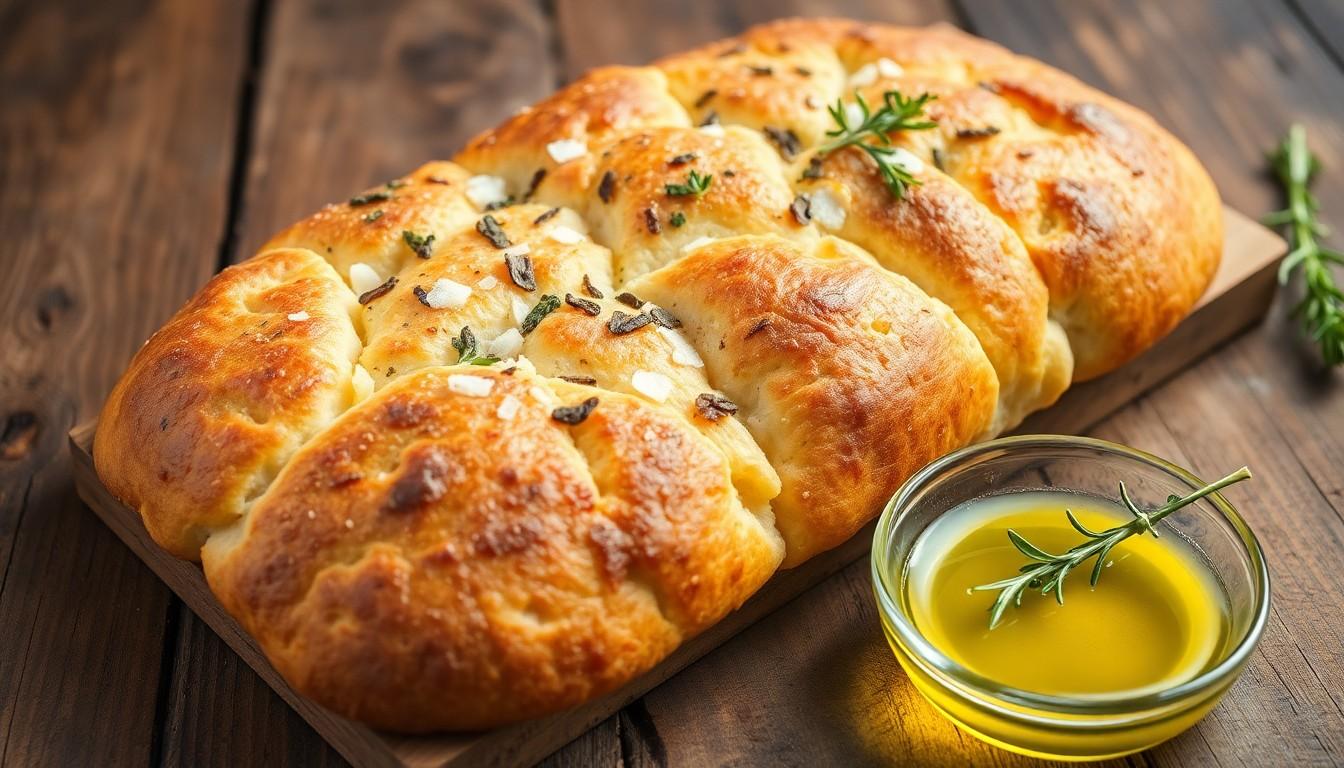Focaccia might just be the bread that dreams are made of. With its golden crust and fluffy interior, it’s hard to resist a slice—or three. But before diving into that heavenly loaf, it’s worth taking a moment to explore what’s happening nutrition-wise. After all, even the most delicious indulgences can have secrets hidden beneath their savory surface.
Table of Contents
ToggleOverview Of Focaccia
Focaccia features a distinct flavor profile, making it a favorite among bread lovers. Often enriched with olive oil, it boasts a moist texture and a slightly chewy crust. Typical ingredients include flour, water, yeast, and salt, giving it a simple yet satisfying composition.
Serving sizes can vary, but a standard piece of focaccia averages around 100 grams. This serving size contains approximately 270 calories, presenting a moderate source of energy.
Focaccia’s nutritional breakdown reveals critical components. Each 100-gram serving typically includes:
| Nutrient | Amount |
|---|---|
| Total Fat | 8 grams |
| Saturated Fat | 1 gram |
| Carbohydrates | 43 grams |
| Protein | 8 grams |
| Fiber | 2 grams |
| Sodium | 500 mg |
Protein content contributes to its fulfilling nature, while carbohydrates provide essential energy. Fiber aids digestion, promoting overall health.
Sodium levels can be significant, particularly when additional toppings enhance flavor. Toppings such as herbs or vegetables elevate both taste and nutritional value.
Current dietary trends emphasize whole grains, and focaccia can be adapted using whole wheat flour for increased fiber. Those who enjoy trying new recipes might incorporate various toppings or herbs for added nutrients and variety.
Focaccia serves not only as a standalone snack but also complements meals remarkably well. Its versatility makes it a delightful choice for many dietary preferences.
Nutritional Composition

Focaccia offers a variety of nutritional benefits, illustrating a balanced mix of macronutrients and micronutrients. Understanding its composition aids in making informed dietary choices.
Macronutrients
Focaccia is primarily composed of carbohydrates, providing around 43 grams per serving, which serves as a significant energy source. Total fat content amounts to 8 grams, while saturated fat is limited to 1 gram, maintaining a heart-healthy profile. Protein counts average at 8 grams, contributing to satiety and muscle repair. Fiber adds 2 grams to the overall nutritional profile, promoting digestive health. Each serving’s moderate calorie count of approximately 270 makes focaccia a tasty yet indulgent option.
Micronutrients
Nutrient content includes key vitamins and minerals that enhance focaccia’s appeal. Sodium reaches 500 mg per serving, which becomes crucial to consider in hypertensive diets. Iron, important for oxygen transport in the body, is available in small amounts. The presence of B vitamins, including niacin and riboflavin, supports energy metabolism and overall health. Additionally, using whole wheat flour can increase fiber content while boosting nutrient diversity. Each enhancement provides a way to enjoy focaccia without sacrificing nutritional integrity.
Health Benefits Of Focaccia
Focaccia offers several health benefits, making it a delightful addition to various diets.
Energy Source
Focaccia serves as a significant energy source due to its carbohydrate content. Each 100-gram serving contains about 43 grams of carbohydrates, providing fuel for daily activities. This feature appeals to those needing quick energy boosts, especially active individuals. The presence of healthy fats, totaling 8 grams per serving, supports overall energy levels. Each slice not only satisfies hunger but also helps in maintaining stamina throughout the day. By incorporating olive oil, focaccia gains healthy unsaturated fats, further enhancing its energy-providing capacity. Simple ingredients contribute to its energy-rich profile, making focaccia suitable for various meals and snacks.
Digestive Health
Focaccia supports digestive health thanks to its fiber content. Each serving offers around 2 grams of dietary fiber, which promotes regular bowel movements. Fiber plays a crucial role in maintaining gut health by aiding digestion and preventing constipation. Incorporating whole wheat flour increases the fiber content significantly, leading to enhanced nutrient absorption and improved digestive function. The fiber present helps balance blood sugar levels, providing additional health advantages. For those monitoring their digestive health, focaccia can be an enjoyable option when prepared with whole grains. Balanced nutrition and satisfying textures make this bread a smart choice for supporting digestive well-being.
Considerations For Dietary Restrictions
Focaccia offers an appealing option but requires careful consideration for individuals with specific dietary needs. Gluten intolerance or celiac disease presents a significant concern; traditional focaccia contains wheat flour. Alternative grains such as almond flour or rice flour yield gluten-free versions suitable for those avoiding gluten.
For people following a vegan diet, focaccia can easily adapt. The standard recipe excludes animal products, making it a viable choice for plant-based eaters. Adding toppings like garlic, rosemary, or tomatoes enhances flavor without compromising dietary guidelines.
Those monitoring sodium intake should heed focaccia’s sodium content of 500 mg per serving. Opting for unsalted versions or reducing the use of added toppings mitigates this concern. Individuals on low-sodium diets may need to exercise caution.
People with diabetes should also observe carbohydrate content, particularly the 43 grams per serving. Using whole wheat flour increases fiber levels, supporting better blood sugar management. Incorporating seeds or nuts can further improve the nutritional profile while providing health benefits.
Lastly, monitoring calorie intake matters for those aiming to maintain a specific weight. With 270 calories per average serving, enjoyment in moderation aligns with weight management goals. Overall, focaccia remains a versatile bread that can fit various dietary restrictions with thoughtful modifications.
Focaccia stands out as a delightful bread option that marries taste with nutritional benefits. Its balance of carbohydrates, protein, and healthy fats makes it a satisfying choice for many. With the potential for modifications like using whole wheat flour or adding nutritious toppings, focaccia can cater to various dietary preferences and restrictions.
While it offers energy and digestive support, those mindful of sodium or calorie intake should enjoy it in moderation. Overall, focaccia isn’t just a treat; it can be a versatile addition to a balanced diet that enhances meals and satisfies cravings.




